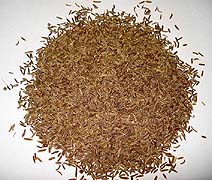Caraway: Benefits and Uses

Caraway is a biennial that grows to 2-3 ft, has a furrowed, hollow stem, finely-cut, feathery leaves, and flat-topped clusters of white flowers in summer. The crescent-shaped, dark brown, aromatic seeds have five distinct ridges.
Records show that caraway has been used for more than 5,000 years, and legend would have us believe that caraway seeds made into a potion and fed to straying husbands made them become faithful. Some pigeon fanciers use the seed in the mash of homing pigeons, so maybe there is some truth in the old legend!
Make a tea with the seeds to use as a digestive to soothe gripe and wind, and as an expectorant. A combination of enteric-coated peppermint oil and caraway can reduce the pain of irritable bowel syndrome. Caraway combined with anise and fennel can effectively deal with windy matters, especially in children.
For enhanced flavor, lightly toast caraway seed before use in cheese dishes or potato salad. Caraway seed is great for use in sauerkraut, soups, and stews; add caraway in the last 15 minutes of cooking for best flavor. Sprinkle caraway seed lightly over spice cakes before baking. Mix 1/4 cup melted butter with 1 to 2 teaspoons caraway seed; spread on French bread or pour over green beans.
In the garden caraway repels aphids, flies, and fruit moths; indoors it deals with mosquitoes.
|